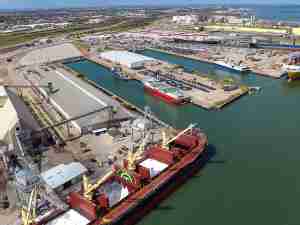Fitch Affirms Canaveral Port Authority Seaport Revs at ‘A’; Outlook Stable
posted by AJOT | Mar 16 2017 at 07:59 AM | Ports & Terminals
Fitch Ratings has affirmed the 'A' rating on approximately $64.6 million of Canaveral Port Authority (CPA) port revenue bonds, series 2016 C&D. The Rating Outlook is Stable.
KEY RATING DRIVERS
Summary: The rating reflects Port Canaveral's (the port) market position as one of the leading cruise-focused ports on the east coast, due in part to its strategic location and proximity to the tourism-based economy of central Florida. While the port's exposure to tourism remains a risk, staggered operating agreements with cruise lines that include minimum guarantees offset some revenue volatility. Cruise traffic has remained resilient through periods of declining discretionary spending. The rating also reflects the port's established operating history, aggressive yet flexible capital program, and conservative debt structure, which have led to modest leverage and solid coverage metrics when compared to peers in the 'A' category.
Cruises Anchor Port Operations (Revenue Risk: Volume - Midrange)
Orlando's tourism market drives the port's Disney, Royal Caribbean, Carnival, and Norwegian cruise traffic, which generates over 80% of port operating revenue. The cruise business has remained resilient during weakening economic cycles and declining discretionary spending, and Canaveral's cruise revenues continued to grow through the recent recession. Cargo operations account for the port's remaining revenue, and provide diversification away from cruise for a small but growing portion of the port's revenues.
Cruise Exposure Mitigated by Contracts (Revenue Risk: Price - Midrange)
While the port remains exposed to the discretionary cruise business, contracts with key cruise lines help to insulate revenue from volume fluctuations. Cruise guarantees accounted for approximately 51% of total operating revenue in 2016. Staggered expirations limit some exposure to renewal of operating agreements; however, renewal risk remains as contracts expire prior to the maturity of the current outstanding debt. Cargo commodity business lines complement cruise activities but are more volatile due to their volume dependency.
Developing, Flexible Capital Program (Infrastructure Development/Renewal - Midrange)
The $408 million 2017-2021 capital improvement program (CIP) is robust, yet remains flexible, with the ability to adjust scale and timing of projects as warranted by demand. Larger near-term projects are cargo focused, as CPA recently completed the expansion and modernization of existing cruise terminals 5 and 8. Further, Fitch expects portions of the CIP, namely channel widening, to be partially offset with money available from state and federal sources.
Conservative Debt Structure (Debt Structure - Stronger)
The port's capital structure includes long-term, fixed-rate revenue bonds that mature in various stages, with final maturity in 2046. The rate covenant and additional bonds test (ABT) provide sound protection, as they are tied to producing at least 1.25x coverage of maximum annual debt service (MADS), which will be reached in fiscal 2029. An additional issuance in 2020 remains uncertain and dependent on cruise demand.
Financial Metrics
The debt service coverage ratio (DSCR) remained strong in 2016 at approximately 2.3x, despite an increase in debt service related to recent bond issuances. Fitch calculated revenue bond net debt-to-cash flow available for debt service (CFADS) increased to around 6.2x in 2016, which was expected as CPA progresses through its capital plan. Fitch expects leverage to decrease to the 4x range, and coverage to remain consistent with historical levels through 2020, absent any additional bond issuances by CPA. Fitch views these metrics as comparable with the 'A' rating.
Peers
CPA's peers include other Florida east coast ports such as Broward County ('A'/Stable Outlook) and Miami-Dade County ('A'/Stable Outlook), which serve similar markets and have sizable cruise operations which compete with the port. Both peer ports have a larger cargo presence and as such, less exposure to a single business line. However, Miami has higher leverage of over 8x as it progresses through its CIP, and Broward's leverage will become more comparable to CPA as it completes its near-term borrowing plan. All three ports remain similar in terms of coverage at around 2x.
FACT Tool
FACT Tool: U.S. Ports (Opens Excel Worksheet)
RATING SENSITIVITIES
Negative: Divergence from projected leverage and coverage ratios due to changes in cost structure, scope of the capital plan, declines in passenger traffic, and/or weakened lease renewal trends;
Positive: Due to the port's elevated leverage profile and uncertainty around future debt issuances as it progresses through its capital program, positive rating action is unlikely at this time.
CREDIT UPDATE
Performance Update
CPA's cruise traffic continues to remain strong and drives the port's stable operating profile. Passenger volume increased approximately 2% in 2016 to 4.2 million, and is up an additional 20% through the first four months of fiscal 2017. Volume growth stemmed from new service, additional ship capacity over prior offerings, and Norwegian cruise line beginning its homeport operation at CPA. Fitch believes CPA is well-positioned for continued cruise passenger growth, though remains susceptible to declines in discretionary income affecting passenger demand.
The port's processed cargo diversifies a small, but growing, portion of CPA's total operation. Processed tonnage increased 32% in 2016, and through four months of fiscal 2017, is up an additional 5%. Increases were driven by continued strong construction activity in Central Florida providing solid growth in slag, limestone, and granite shipping. Processed petroleum also contributed to CPA's tonnage growth, and remains a substantial portion of shipping activity as the port supplies fuel to Orlando International Airport. While cargo shipping remains volatile, Fitch believes CPA's tonnage levels are well-positioned for additional growth as the port completes new portions of its CIP. Also, the port's minimum annual guarantees, which totaled $49.9 million (58% of total revenue) in fiscal 2016, offset some exposure to volatile commodities shipping and the discretionary nature of the cruise industry.
CPA's current 2017-2021 CIP totals $408.7 million and is primarily cargo focused, as CPA continues to capitalize on its available capacity relative to nearby, competing ports. The expansion and modernization of cruise terminals 5 and 8 is now complete. A bond issuance in 2020 for the construction of an additional cruise terminal remains uncertain and based on passenger demand. Fitch views positively the involvement from cruise partners in past capital developments at the port, namely the development of terminal 8. The port has demonstrated a favorable track record of project delivery with no material cost overruns to date, and projects remain generally flexible in the event of lower than expected cash flow.
Total 2016 revenue increased 10% to $85.5 million, driven by CPA's aforementioned volume growth. Operating expenses (net of depreciation and amortization expenses) grew 8% to $39.5 million as additional portions of the CIP were completed and the port's operations increased. Debt service coverage remained strong at 2.3x in 2016, up from 2.1x in 2015. CPA's leverage increased to a Fitch-calculated approximately 6.2x in 2016. Both metrics remain in line with peers in the 'A' category. Fitch expects CPA's financial metrics to continue to remain strong with any additional leverage in 2020 to be offset by continued growth in cruise and passenger revenue.
Fitch Cases
Fitch's base case assumes an approximately 4% CAGR in cruise related revenue and a roughly 3% CAGR in cargo related revenue, driven by increases in the port's tariffs, CIP completion, and increased ship activity. Expense growth at an approximately 7% CAGR provides the port with coverage levels that remain above 2x through 2021. Leverage declines to the 4x range by 2021 as the port's current debt amortizes, and CPA builds its liquidity balance.
Fitch's rating case contemplates debt service coverage levels under a scenario of economic decline. The rating case assumes a sharp decline in 2018 in cruise and cargo revenue along with higher overall expense growth, which results in coverage levels falling to the high 1x range and leverage remaining in the 6x range though 2021. The port retains flexibility in its capital program depending on demand and the timing of grant funding; however, Fitch's rating case assumes all projects are undertaken, and includes an additional bond issuance in 2020. Including the projects and increased debt quantum, metrics in the rating case remain consistent with the other 'A' rated ports in their respective rating case profiles.










